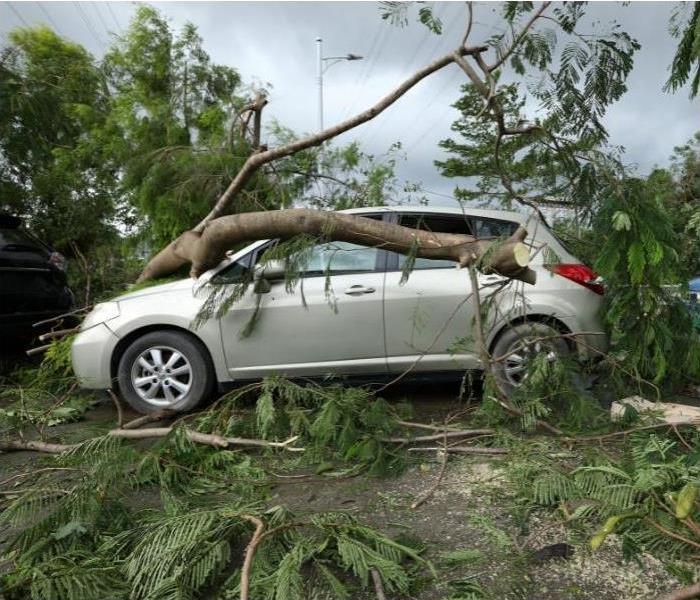How to Recover from Storm Damage
11/17/2023 (Permalink)
The Devastating Impact of Storm Damage
Storms, in their various forms, can leave a trail of destruction in their wake, causing damage to homes, properties, and infrastructure. From the relentless fury of hurricanes to the sudden fury of tornadoes, the aftermath of a storm can be daunting. Understanding how to recover from storm damage is essential for homeowners and property owners amid nature's fury.
Importance of Swift Recovery
Recovery from storm damage is not just about restoring your property; it's about regaining a sense of normalcy. Swift and efficient recovery can significantly reduce the emotional and financial toll of the aftermath. This article from SERVPRO will explore the essential steps to help you recover from storm damage and rebuild your life.
Assessing the Damage
Conducting a Safety Check
Before diving into the property damage assessment, ensuring personal safety is crucial. Before proceeding, check for any immediate dangers, such as downed power lines or unstable structures. Your safety and your family's safety should always be the top priority.
Documenting the Damage
Once you've ensured safety, begin documenting the extent of the damage. Take photographs and videos of the affected areas. Detailed documentation will be crucial when dealing with insurance claims and contractors. Make a list of damaged items and structures.
Contacting Insurance Providers
Promptly inform your insurance provider about the damage. Contact your insurance company to initiate the claims process. Be prepared to provide all the necessary information and documentation to support your claim.
III. Emergency Repairs and Safety Measures
Securing Your Home
If your home is structurally compromised, it's essential to secure it to prevent further damage. This may involve covering holes in the roof or walls, bracing unstable structures, or boarding up broken windows. Temporary fixes can prevent additional issues while you plan for more extensive repairs.
Addressing Electrical and Gas Issues
Storms can damage utility lines, posing a severe risk. If you suspect electrical or gas issues, shut off the main power and gas supplies. Contact a professional to assess and repair any damage to these systems.
Dealing with Water Damage
Water damage is common in storm-ravaged properties. Swift action to remove water and dry affected areas can prevent mold growth and further structural damage. Consider enlisting the help of professionals with the necessary equipment for water extraction and drying.
Seeking Professional Assistance
Hiring Certified Contractors
Engaging qualified contractors is crucial for the restoration process. Look for professionals experienced in storm damage repair, like SERVPRO.
Government Assistance Programs
In the case of large-scale disasters, government assistance programs may be available to provide financial aid for recovery efforts. Check with local and federal agencies for information on available programs and eligibility requirements.
Navigating the Insurance Claim Process
Filing a Claim Promptly
Time is of the essence when dealing with insurance claims. File your claim as soon as possible to expedite the process. Most policies have specific timeframes for reporting storm damage.
Understanding Policy Coverage
Thoroughly review your insurance policy to understand what is covered and what is not. Knowing the limitations of your coverage can prevent surprises during the claims process. If you have questions, consult your insurance agent.
Providing Evidence and Documentation
Submit all the evidence and documentation you collected during your damage assessment. Proper documentation can streamline the claims process and help you receive a fair settlement.
Restoration and Rebuilding
Creating a Recovery Plan
Work with contractors to create a detailed recovery plan. This plan should outline the scope of work, a timeline, and the estimated costs. Having a clear plan will help you stay organized and on budget.
Selecting Materials and Contractors
Carefully choose the materials and contractors for your restoration project. Opt for durable, storm-resistant materials to prevent future damage. Select reputable contractors with a track record of quality work, such as SERVPRO.
Keeping an Eye on the Budget
Restoration projects can be costly. Keep a close eye on your budget to avoid overspending. Consider seeking competitive bids and exploring financing options if needed.
Preventive Measures for Future Storms
Reinforcing Your Property
Invest in measures to reinforce your property against future storms. This may include strengthening the roof, installing impact-resistant windows, or securing outdoor structures.
Investing in Storm-Resistant Features
Consider incorporating storm-resistant features into your property's design. These may include hurricane straps, wind-resistant garage doors, and elevated electrical systems.
Having an Emergency Preparedness Plan
Develop an emergency preparedness plan for your family. Ensure everyone knows what to do and where to go in a storm. Stock up on essential supplies, including non-perishable food, water, and first-aid kits.
In the aftermath of a storm, the path to recovery may seem daunting, but with careful planning and decisive action, you can rebuild your life and property. By following these steps and seeking professional assistance when needed, you can navigate the challenges of storm damage and emerge stronger on the other side.




 24/7 Emergency Service
24/7 Emergency Service
